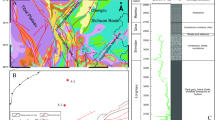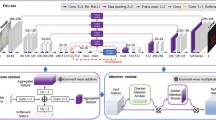Abstract
The seismic phenomenon is the primary basis for identifying the seismic damage class of reinforced concrete (RC) columns. Then, the previous seismic damage assessment required the evaluators to be experienced, while the assessment was costly and time-consuming. This study has developed an economical, efficient, and practical model to determine the seismic damage class of RC columns based on seismic damage images. Experiments of eight RC columns with different parameters were carried out to collect seismic damage images and force–displacement curves to establish a correspondence between damage indices, damage classes, and macroscopic seismic damage phenomena. A multi-source seismic damage dataset of RC columns was constructed, in which 450 experimental damage images were used as the training set and validation set, and 75 post-earthquake damage images were used as the test set. The Deep Contrasted Attention (DCA) model innovatively proposed in this study is used to determine the seismic damage class of RC columns. The DCA model uses Siamese Neural Network as the main network and Visual Geometry Group as a sub-network with the addition of Attention Mechanism (Convolutional Block Attention Module, CBAM), optimized with metric learning. Gradient-weighted Class Activation Mapping module is generated to visualize the visual heat map of RC column surface damage class intuitively. Compared with previous algorithms, the DCA model has excellent accuracy and generalization, with 93.7%, 88.6%, and 90.7% accuracy for the training set, validation set, and test set, respectively. In this study, the validity of the model in assessing the seismic damage rating of RC columns in practical applications is verified, and the experimental results provide intelligent support for in post-earthquake safety assessment.





















Similar content being viewed by others
Data availibility
The models and codes that support the findings of this study are available from the corresponding author upon reasonable request.
References
Huang F, Li M, Ma Y, Han Y, Tian L, Yan W, Li X (2017) Studies on earthquake precursors in China: a review for recent 50 years. Geodesy Geodyn 8(1):1–12
Sun B, Zhang G (2010) The Wenchuan earthquake creation of a rich database of building performance. Sci China Technol Sci 53(10):2668–2680
Park YJ, Ang AHS, Wen YK (1985) Seismic damage analysis of reinforced concrete buildings. J Struct Eng 111(4):740–757
Dogan G, Arslan MH, Baykan OK (2020) Determination of damage levels of RC columns with a smart system oriented method. Bull Earthq Eng 18(7):3223–3245
Bao Y, Tang Z, Li H, Zhang Y (2019) Computer vision and deep learning-based data anomaly detection method for structural health monitoring. Struct Health Monit 18(2):401–421
Dung CV (2019) Autonomous concrete crack detection using deep fully convolutional neural network. Autom Constr 99:52–58
Feng C, Liu MY, Kao CC, Lee TY (2017) Deep active learning for civil infrastructure defect detection and classification. In Computing in civil engineering 2017, pp 298–306
Gao Y, Mosalam KM (2018) Deep transfer learning for image-based structural damage recognition. Comput Aid Civ Infrastruct Eng 33(9):748–768
Naito S, Tomozawa H, Mori Y, Nagata T, Monma N, Nakamura H, Shoji G (2020) Building-damage detection method based on machine learning utilizing aerial photographs of the Kumamoto earthquake. Earthq Spectra 36(3):1166–1187
Cao QD, Choe Y (2020) Building damage annotation on post-hurricane satellite imagery based on convolutional neural networks. Nat Hazards 103(3):3357–3376
Zhang Y, Burton HV, Sun H, Shokrabadi M (2018) A machine learning framework for assessing post-earthquake structural safety. Struct Saf 72:1–16
Ma H, Liu Y, Ren Y, Yu J (2019) Detection of collapsed buildings in post-earthquake remote sensing images based on the improved YOLOv3. Remote Sens 12(1):44
Zhang J, Chen Y, Zhai Y (2020) Zero-shot classification based on word vector enhancement and distance metric learning. IEEE Access 8:102292–102302
Opitz M, Waltner G, Possegger H, Bischof H (2018) Deep metric learning with bier: boosting independent embeddings robustly. IEEE Trans Pattern Anal Mach Intell 42(2):276–290
Zhe X, Chen S, Yan H (2019) Directional statistics-based deep metric learning for image classification and retrieval. Pattern Recogn 93:113–123
Fathi A, Wojna Z, Rathod V, Wang P, Song HO, Guadarrama S, Murphy KP (2017) Semantic instance segmentation via deep metric learning. arXiv preprint arXiv:1703.10277
Tao D, Guo Y, Song M, Li Y, Yu Z, Tang YY (2016) Person re-identification by dual-regularized kiss metric learning. IEEE Trans Image Process 25(6):2726–2738
Hackel T, Usvyatsov M, Galliani S, Wegner JD, Schindler K (2020) Inference, learning and attention mechanisms that exploit and preserve sparsity in CNNs. Int J Comput Vis 128(4):1047–1059
Sarafianos N, Xu X, Kakadiaris IA (2018) Deep imbalanced attribute classification using visual attention aggregation. In Proceedings of the European Conference on Computer Vision (ECCV), pp 680-697
Zhai X, Wei W (2019) Emotional analysis of neural network text combined with attention mechanism. Int Core J Eng 5(10):123–128
Sangeroki BA, Cenggoro TW (2021) A fast and accurate model of thoracic disease detection by integrating attention mechanism to a lightweight convolutional neural network. Procedia Comput Sci 179:112–118
China Academy of Building Research (1996). Specification of test methods for earthquake resistant building. JGJ101-96
Bowen Q, Haoyu Z, Chenxi M (2018) Quantitative seismic damage assessment method for reinforced concrete frame column. Word Earthq Eng 34(3):85–93
Sun B (2014) Sichuan Lushan “420” 7.0 magnitude strong earthquake building damage atlas (in Chinese). Earthquake Press
GB 18208.2-2001 (2001) Post-earthquake field works, part 2: safety assessment of buildings
Park YJ, Ang AHS (1985) Mechanistic seismic damage model for reinforced concrete. J Struct Eng 111(4):722–739
Valles RE, Reinhorn AM, Kunnath SK, Li C, Madan A (1996) IDARC 2D version 4.0: a program for the inelastic damage analysis of buildings. Rep. No. NCEER 96, 10
Bracci JM, Reinhorn AM, Mander JB, Kunnath SK (1989) Deterministic model for seismic damage evaluation of RC structures. Rep NCEER 89:33
Taigman Y, Yang M, Ranzato MA, Wolf L (2014) Deepface: closing the gap to human-level performance in face verification. In: Proceedings of the IEEE conference on computer vision and pattern recognition, pp 1701–1708
Jiang JR, Lee JE, Zeng YM (2019) Time series multiple channel convolutional neural network with attention-based long short-term memory for predicting bearing remaining useful life. Sensors 20(1):166
Xu G, Liu M, Jiang Z, Shen W, Huang C (2019) Online fault diagnosis method based on transfer convolutional neural networks. IEEE Trans Instrum Meas 69(2):509–520
Shaowu S, Sheng Z, Wanlu J, Zhenbao L (2020) Study on the health condition monitoring method of hydraulic pump based on convolutional neural network. In: 2020 12th International conference on measuring technology and mechatronics automation (ICMTMA). IEEE, pp 149–153
Koch G, Zemel R, Salakhutdinov R (2015) Siamese neural networks for one-shot image recognition. In ICML deep learning workshop, vol 2
Wang S, Xiang J (2020) A minimum entropy deconvolution-enhanced convolutional neural networks for fault diagnosis of axial piston pumps. Soft Comput 24(4):2983–2997
Zhang Y, Duan Z (2018) Visualization and interpretation of Siamese style convolutional neural networks for sound search by vocal imitation. In: 2018 IEEE international conference on acoustics, speech and signal processing (ICASSP). IEEE, pp 2406–2410
Niu Z, Zhong G, Yu H (2021) A review on the attention mechanism of deep learning. Neurocomputing 452:48–62
Woo S, Park J, Lee JY, Kweon IS (2018) Cbam: convolutional block attention module. In Proceedings of the European conference on computer vision (ECCV), pp 3–19
Zeiler MD, Fergus R (2014) Visualizing and understanding convolutional networks. European conference on computer vision. Springer, Cham, pp 818–833
Zagoruyko S, Komodakis N (2016) Paying more attention to attention: improving the performance of convolutional neural networks via attention transfer. arXiv preprint arXiv:1612.03928
Selvaraju RR, Cogswell M, Das A, Vedantam R, Parikh D, Batra D (2017) Grad-cam: visual explanations from deep networks via gradient-based localization. In: Proceedings of the IEEE international conference on computer vision, pp 618–626
Zhang G, Sun B, Bai W, Zhang H (2022) Prediction of the yield performance and failure mode of RC columns under cyclic-load by PSO-BP neural network. Buildings 12(5):507
Park SE, Eem SH, Jeon H (2020) Concrete crack detection and quantification using deep learning and structured light. Constr Build Mater 252:119096
Pathirage CSN, Li J, Li L, Hao H, Liu W, Ni P (2018) Structural damage identification based on autoencoder neural networks and deep learning. Eng Struct 172:13–28
Acknowledgements
The work presented in this paper was supported by National Key R &D Program of China (Grant no. 2019YFC1509301), Scientific Research Fund of Institute of Engineering Mechanics, China Earthquake Administration (Grant no. 2019EEEV0103), and Program for Innovative Research Team in China Earthquake Administration.
Author information
Authors and Affiliations
Corresponding author
Ethics declarations
Conflict of interest
The authors declare that they have no conflict of interest.
Additional information
Publisher's Note
Springer Nature remains neutral with regard to jurisdictional claims in published maps and institutional affiliations.
Rights and permissions
Springer Nature or its licensor holds exclusive rights to this article under a publishing agreement with the author(s) or other rightsholder(s); author self-archiving of the accepted manuscript version of this article is solely governed by the terms of such publishing agreement and applicable law.
About this article
Cite this article
Zhang, G., Sun, B., Wang, S. et al. RC column damaged classification based on deep contrasted attention. J Civil Struct Health Monit 13, 15–33 (2023). https://doi.org/10.1007/s13349-022-00619-8
Received:
Revised:
Accepted:
Published:
Issue Date:
DOI: https://doi.org/10.1007/s13349-022-00619-8




